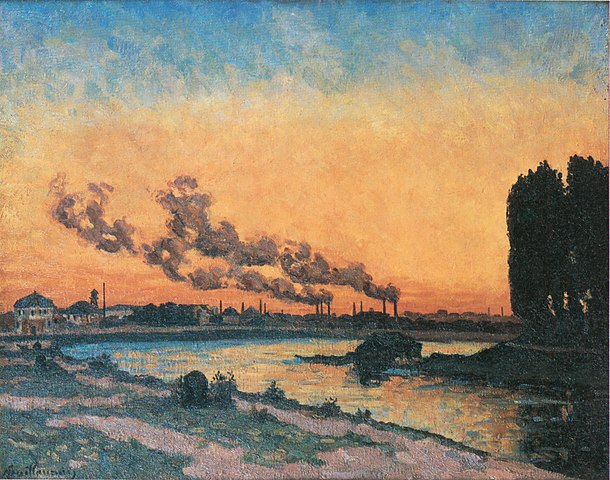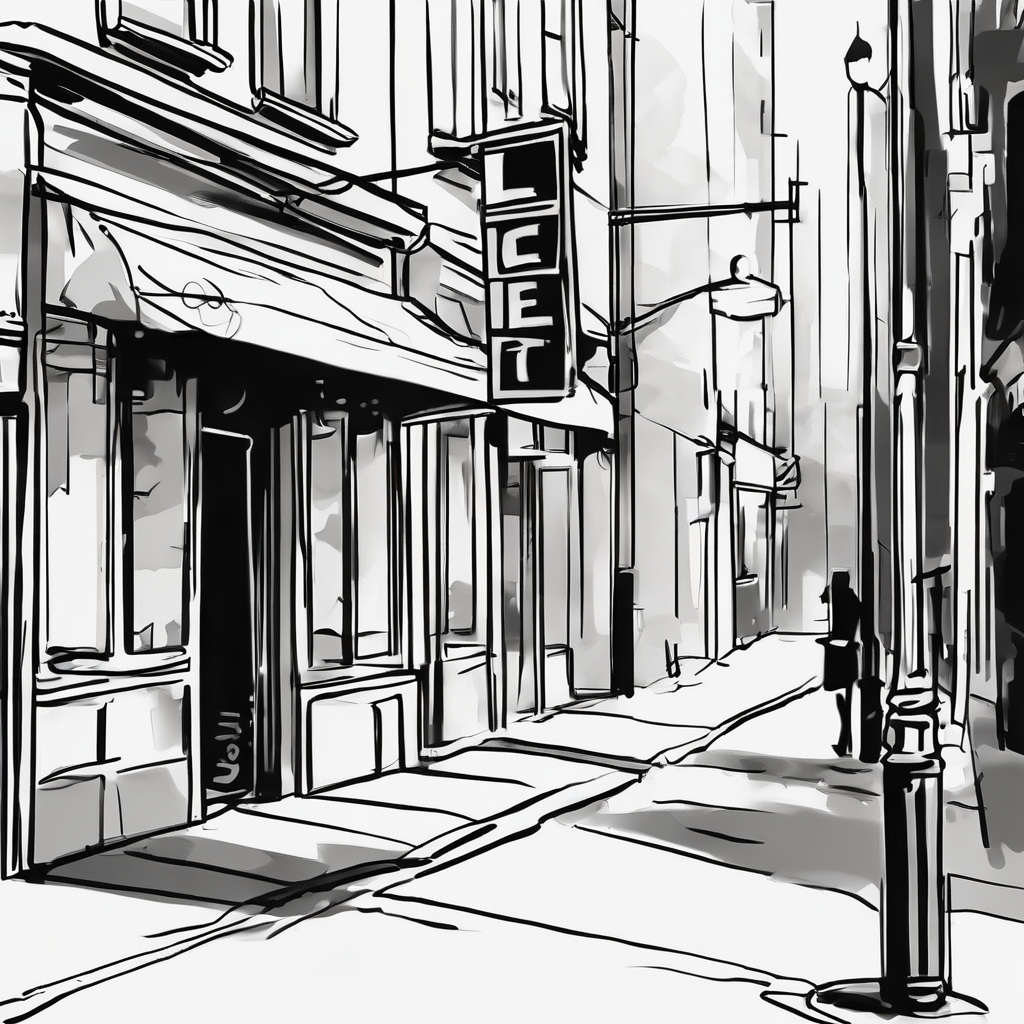Every artist knows that feeling when you sit down with a blank page and your mind goes completely empty. Whether you’re just starting your artistic journey or you’ve been drawing for years, creative block can hit anyone at any time. That’s where sketching prompts come to the rescue! These simple, focused ideas give your creativity the gentle push it needs to get flowing again. Think of sketching prompts as your artistic best friend – always there when you need inspiration, never judging your work, and constantly helping you discover new ways to see the world around you.
Key Points Summary
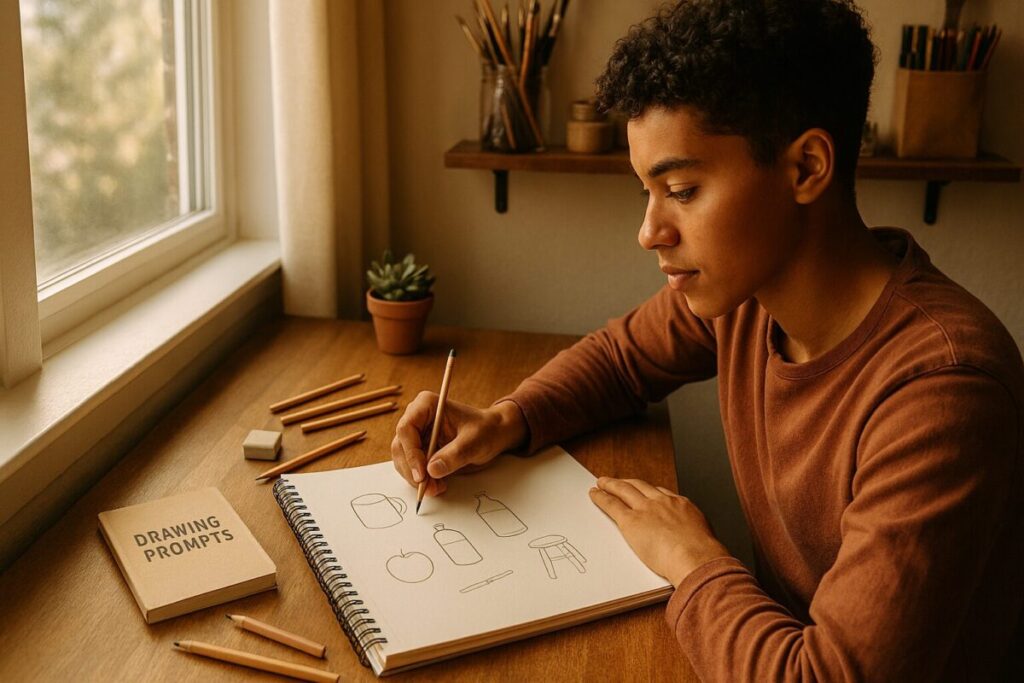
- Sketching prompts are simple drawing ideas that spark creativity and overcome art block
- Regular practice with prompts builds artistic confidence and technical skills
- Simple subjects like everyday objects make the best starting points for beginners
- Daily sketching challenges create consistent artistic growth
- Prompts work for all skill levels, from complete beginners to professional artists
What Are Sketching Prompts and Why Do They Work?
Sketching prompts are basically starter ideas that give you something specific to draw. Instead of staring at a blank page wondering “what should I draw?“, you have a clear direction. Think of them like writing prompts, but for artists.
The magic happens because prompts remove the pressure of coming up with the “perfect” idea. When you’re not worried about what to draw, you can focus on the fun part – actually drawing! This is especially helpful when dealing with creative blocks, which often happen when we put too much pressure on ourselves to create something amazing.
Scientists who study creativity have found that constraints actually boost creative thinking. When you have too many choices, your brain gets overwhelmed. But when you have a specific prompt like “draw your coffee mug,” your mind can relax and focus on observation and technique instead of decision-making.
15 Simple Sketching Prompts to Get You Started
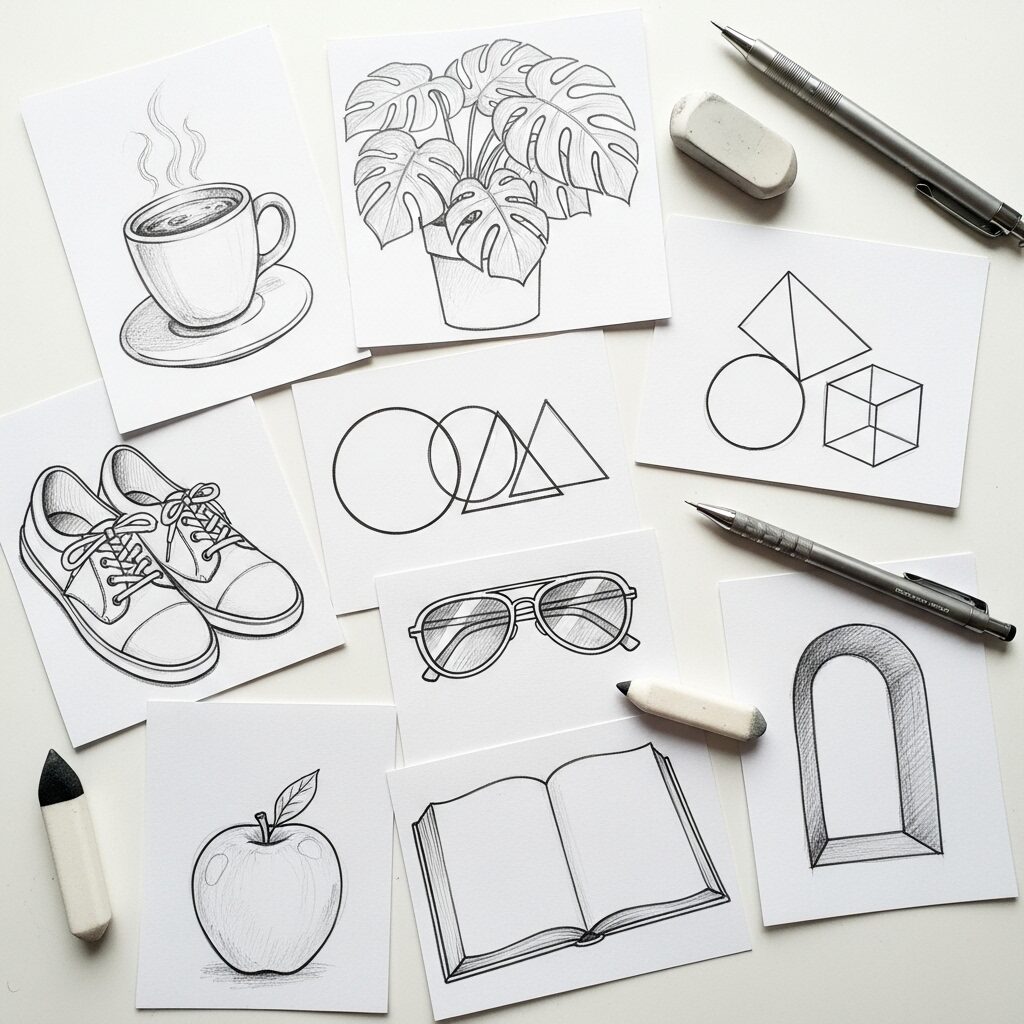
Ready to dive in? Here are some beginner-friendly prompts that work great for daily drawing practice:
Everyday Objects
- Your morning coffee cup (steam included!)
- A houseplant from different angles
- Your favorite pair of shoes
- The view from your window
- Your pet sleeping (or a photo of one)
Quick 5-Minute Sketches
- Draw your hand in three different positions
- Sketch basic shapes: cube, sphere, cylinder
- Your keys and wallet
- A piece of fruit with interesting shadows
- The corner of a room
Observation Challenges
- Draw without looking at your paper (contour drawing)
- Sketch the same object in different lighting
- Draw your reflection in a spoon or curved surface
- Capture movement – a person walking, leaves blowing
- Practice drawing from memory after studying an object
These creative drawing prompts work because they focus on things you see every day, but force you to really look at them as an artist would.
How Sketching Prompts Help Overcome Creative Block
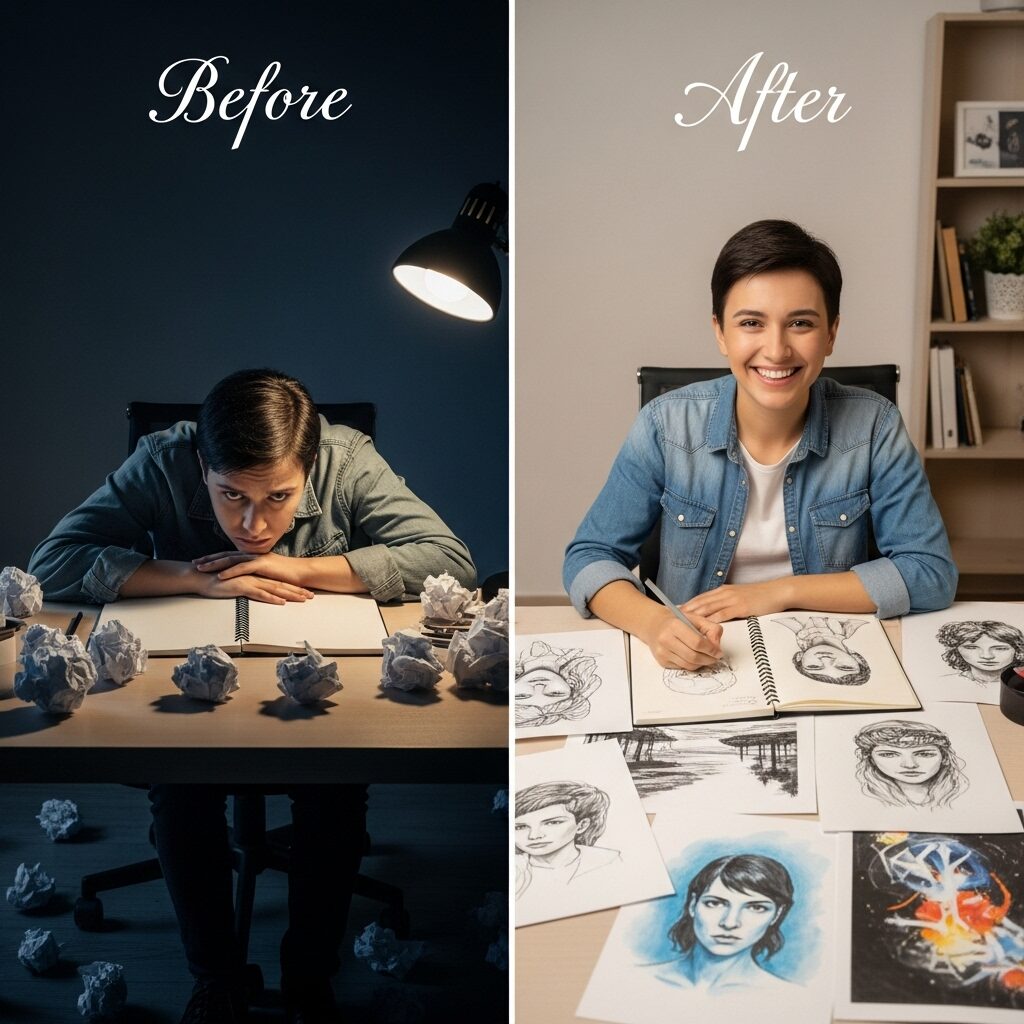
Creative block isn’t just “not knowing what to draw” – it’s often fear in disguise. Fear that your drawing won’t look good enough, fear of wasting time, or fear of not improving fast enough. When you’re stuck in this cycle, sketching prompts act like a creative circuit breaker.
Breaking the Perfectionism Trap
Prompts give you permission to experiment without the pressure of creating a masterpiece. When your goal is simply “draw this apple,” you’re not worried about making gallery-worthy art. This mental shift is huge for getting past creative blocks.
Building Drawing Confidence
Regular practice with simple prompts builds what psychologists call “self-efficacy” – basically, confidence in your ability to do something. Each completed sketch, even if it’s not perfect, proves to your brain that you CAN draw.
Developing Observation Skills
Most drawing problems aren’t actually drawing problems – they’re seeing problems. Prompts train you to really look at things. When you draw that coffee cup for the fifth time, you start noticing details you missed before: how the handle casts a shadow, how the rim creates an ellipse from your viewing angle.
As renowned artist Betty Edwards explains in her research,
“The ability to perceive the way things look is not the same as the ability to draw.”
Prompts bridge this gap by giving you specific things to observe and practice drawing.
Creating Your Daily Sketching Practice
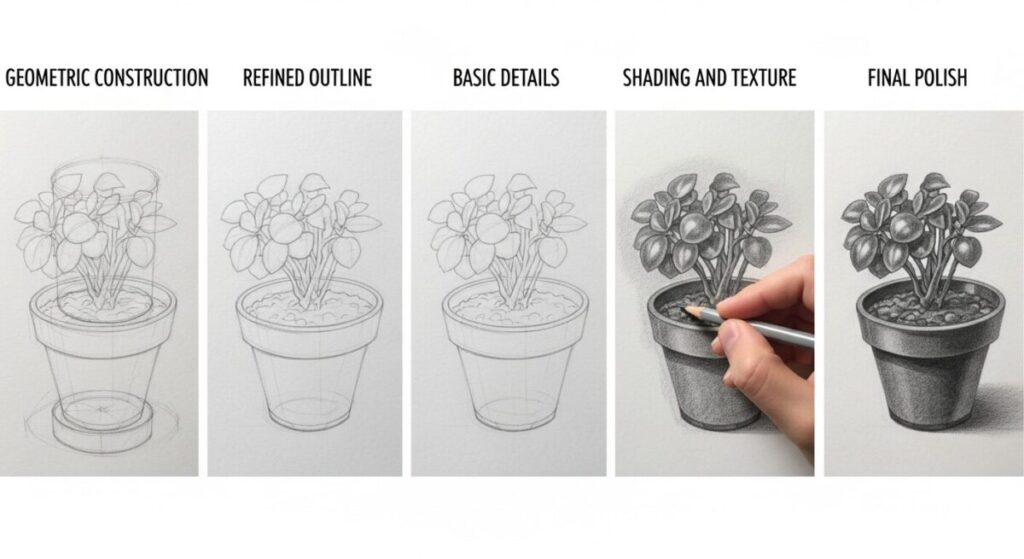
Break down complex subjects into simple shapes to make sketching more approachable
The key to improvement isn’t doing one amazing drawing – it’s doing lots of okay drawings consistently. Here’s how to build a sustainable sketching routine:
Start Small: The 15-Minute Rule
Commit to just 15 minutes a day. That’s it. Most people can find 15 minutes, and starting small helps you build the habit without feeling overwhelmed. You can always draw longer if you’re feeling inspired, but you’re only required to do 15 minutes.
Pick Your Time
Choose the same time each day for your sketching practice. Maybe it’s with your morning coffee, during lunch break, or while winding down in the evening. Consistency in timing helps the habit stick.
Keep a Dedicated Sketchbook
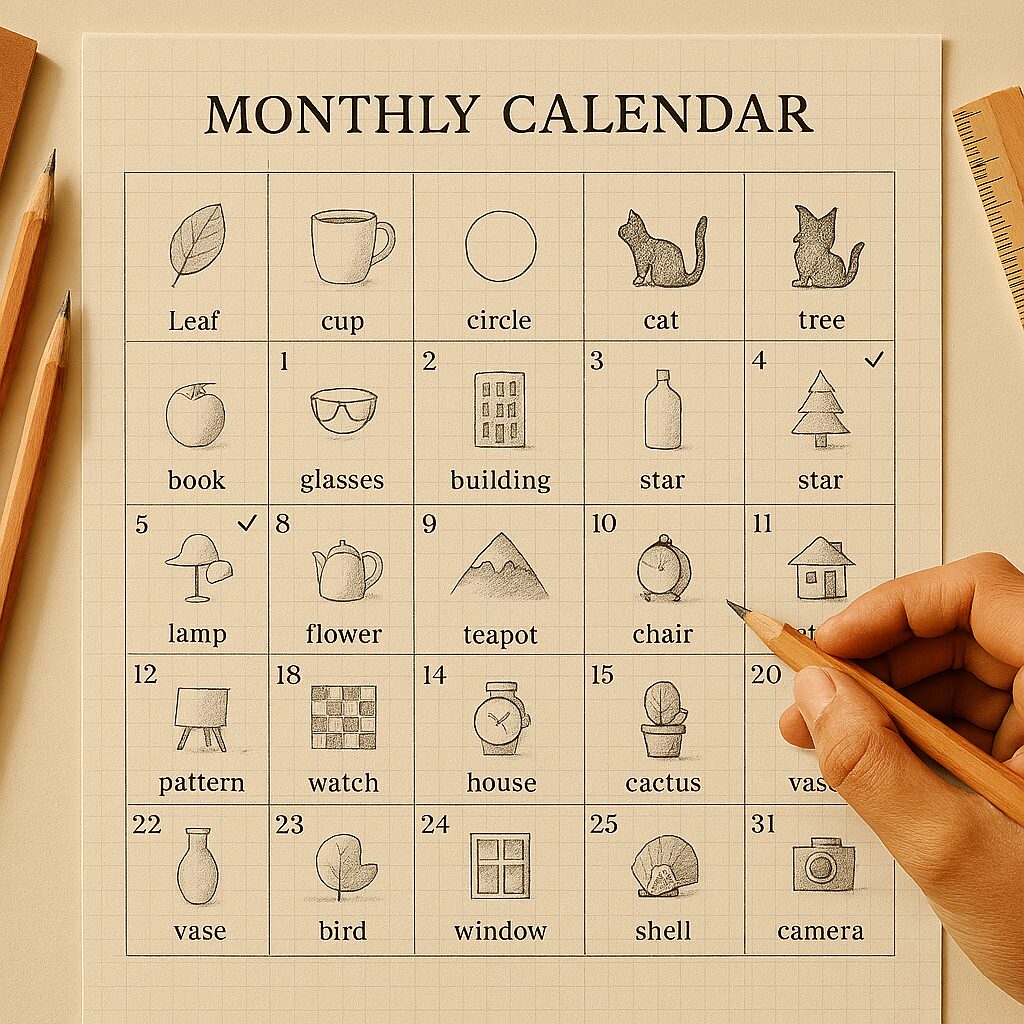
Having a special sketchbook just for prompt practice makes the activity feel more important. It doesn’t need to be expensive – even a simple spiral notebook works great for beginners.
Track Your Progress
Keep a simple log of what you drew each day. You’ll be amazed at how much variety you can create with simple prompts, and looking back at earlier sketches shows your improvement over time.
Advanced Techniques for Using Drawing Prompts
Once you’re comfortable with basic prompts, you can add some challenges to keep growing:
Time-Based Challenges
- Gesture sketching: Capture the essence of a subject in 30 seconds to 2 minutes
- Extended studies: Spend 30+ minutes on a single prompt, focusing on details and shading
- Speed rounds: Set a timer and do multiple quick sketches of the same subject
Subject-Specific Focus Weeks
Dedicate a week to one type of subject:
- Nature week: Leaves, flowers, trees, rocks
- Architecture week: Buildings, doors, windows, bridges
- People week: Faces, hands, figures, expressions
Technical Skill Building
Use prompts to practice specific techniques:
- Value studies: Focus only on light and shadow, no outlines
- Contour drawing: Draw only the edges and outlines
- Texture practice: Choose subjects with interesting surfaces
Using Online Sketching Apps for Digital Practice
AI Sketch Converter: Transform Images to Professional Line Art in Seconds
Our free AI Sketch Converter lets anyone create stunning line art from text prompts or uploaded images with zero technical skills. Unlike other tools requiring API keys or complex setups, our solution works entirely in your browser with no downloads. Simply enter a description in the text-to-sketch tab or upload an image to convert it to sketch format. The tool automatically tries multiple AI services for best results, falling back to client-side processing if needed. With professional-quality output, privacy protection (your images never leave your device), and mobile-friendly design, it’s the most reliable free sketch converter available. Transform ordinary visuals into artistic masterpieces in just one click!
AI Sketch Converter
- Might be slow during peak times
- May fail if API is rate limited
- Includes a small watermark
Your sketch will appear here
While traditional pencil and paper sketching has its charm, digital sketching apps open up exciting new possibilities for prompt-based practice. These apps offer unique advantages that can enhance your artistic development.
Benefits of Digital Sketching Apps
Instant Access to Tools: Digital apps give you access to unlimited pencils, brushes, erasers, and colors without carrying a bag full of supplies. You can switch between different drawing tools instantly, making it easier to experiment with various techniques.
Undo Function: One of the biggest advantages is the ability to undo mistakes instantly. This reduces the fear of "messing up" a drawing and encourages more experimental approaches to prompts.
Layer System: Most apps let you work in layers, which means you can sketch your basic shapes on one layer and add details on another. This makes it easier to follow the step-by-step approach many prompts require.
Top Free Sketching Apps for Beginners
| App Name | Platform | Best For |
|---|---|---|
| Autodesk SketchBook | iOS, Android, Desktop | Realistic pencil and brush feel |
| Adobe Fresco | iOS, Android | Watercolor and oil painting effects |
| Procreate Pocket | iOS only | Professional-level tools on mobile |
| Krita | Desktop, Android | Full-featured digital art suite |
| ArtRage | iOS, Android, Desktop | Traditional media simulation |
Digital-Specific Prompts to Try
Digital tools allow for some unique prompt categories:
- Color exploration: Use the same prompt but try it in different color schemes
- Brush experiments: Draw the same subject with different digital brushes
- Time-lapse creation: Many apps record your drawing process automatically
- Texture overlays: Experiment with digital textures and patterns
- Multiple iterations: Save different versions as you work through a prompt
Combining Digital and Traditional Practice
You don't have to choose between digital and traditional sketching. Many successful artists use both:
- Sketch traditionally in the morning, digitally in the evening
- Use digital apps for quick gesture studies, paper for detailed work
- Start prompts digitally to experiment, then recreate favorites on paper
- Use your phone's camera to capture reference photos for traditional sketching
The key is finding what works best for your learning style and schedule.
Building Long-Term Artistic Growth Through Prompts
The real power of sketching prompts isn't just overcoming temporary creative blocks – it's building lasting artistic skills. Think of each prompt as a small investment in your artistic development.
Developing Your Artistic Voice
As you work through hundreds of prompts over time, you'll start noticing patterns in what you enjoy drawing and how you naturally approach different subjects. This is how you develop your unique artistic style – not by trying to copy others, but by discovering what feels natural to you.
Creating a Visual Vocabulary
Every subject you draw becomes part of your visual vocabulary. The more you practice drawing different things, the easier it becomes to combine them in original compositions later.
Building Technical Confidence
Regular practice with varied subjects builds your technical skills across the board. Drawing geometric shapes improves your understanding of form. Sketching plants teaches you about organic curves. Portrait practice develops your ability to see proportions.
"I have not failed. I've just found 10,000 ways that won't work."
Thomas Edison
This famous quote applies perfectly to art. Each sketch you do, whether it turns out exactly as you hoped or not, teaches you something new about drawing.
Measuring Your Progress
One of the most rewarding parts of using sketching prompts regularly is seeing your improvement over time. Here are some ways to track your growth:
| Time Period | What to Look For |
|---|---|
| After 1 week | More confident lines, less erasing |
| After 1 month | Better proportions, improved observation |
| After 3 months | Consistent quality, personal style emerging |
| After 6 months | Complex subjects feel manageable |
| After 1 year | Significant technical growth, unique voice |
Troubleshooting Common Challenges
"My sketches don't look like the real thing"
This is completely normal! Remember, you're training your brain to see like an artist. Every professional artist has thousands of "not quite right" sketches behind them. Focus on progress, not perfection.
"I keep drawing the same things"
Branch out gradually. If you love drawing flowers, try different types of flowers, then other plants, then objects with similar curved forms. Gentle expansion works better than dramatic changes.
"I don't have time for daily practice"
Even 5 minutes counts! You can sketch during your commute (if you're not driving!), while waiting in line, or during TV commercial breaks. The key is consistency, not duration.
For more detailed guidance on building a sustainable practice, check out our comprehensive guide on drawing for beginners.
FAQs About Sketching Prompts
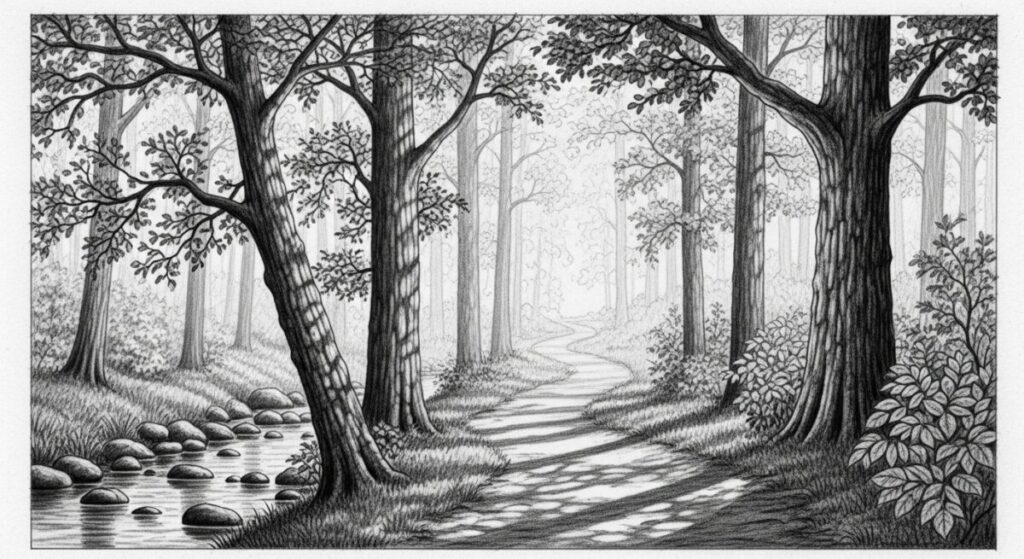
What are sketching prompts and how do they help?
Sketching prompts are specific drawing ideas or subjects that give you direction when you don't know what to draw. They help by removing the decision fatigue of choosing a subject, allowing you to focus on the actual drawing process.
How often should I use drawing prompts?
Daily practice works best for building skills and maintaining creative momentum. However, even 3-4 times per week can lead to significant improvement over time.
Can sketching prompts improve my drawing skills?
Absolutely! Regular practice with varied prompts builds observation skills, hand-eye coordination, and technical confidence. Each prompt challenges you to see and draw something new.
What materials do I need for sketching prompts?
You can start with just a pencil and paper! As you develop, you might want to explore different pencils (2H for light lines, 6B for dark shading), erasers, and blending tools.
Are there sketching prompts for different skill levels?
Yes! Beginners can start with simple geometric shapes and everyday objects, while advanced artists can tackle complex subjects like figure drawing or architectural details.
How do I create my own sketching prompts?
Look around your environment for interesting subjects. Consider lighting, texture, shape, and emotional content. You can also adapt prompts from creative art challenges you find online.
What if I don't like my sketches from prompts?
Remember that not every sketch needs to be a masterpiece! The goal is practice and learning. Even "failed" sketches teach you something valuable about observation or technique.
Can I use the same prompt multiple times?
Definitely! Drawing the same subject multiple times helps you notice new details and improve your technique. Many artists return to favorite subjects regularly.
Sketching prompts are more than just drawing ideas – they're your pathway to consistent artistic growth and creative confidence. Whether you're just starting out or you're an experienced artist looking to break through a creative block, these simple tools can transform your art practice. The key is to start small, stay consistent, and remember that every sketch is a step forward in your artistic journey. So grab your sketchbook, pick a prompt, and start drawing. Your creativity is waiting to be unleashed, one simple sketching prompt at a time.
Additional Resources
- Drawabox.com - Free drawing course with structured lessons and exercises
- Proko - Professional art instruction videos and courses
- Urban Sketchers - Global community of location sketchers with local chapters
- Artist's Network - Art tutorials, techniques, and inspiration
- Drawing on the Right Side of the Brain - Betty Edwards' research-based approach to drawing
- Quickposes - Timed figure drawing practice with photo references
- Line of Action - Free gesture drawing practice tools and references

